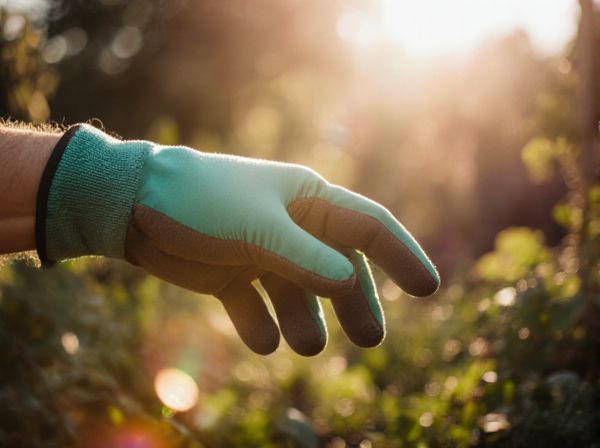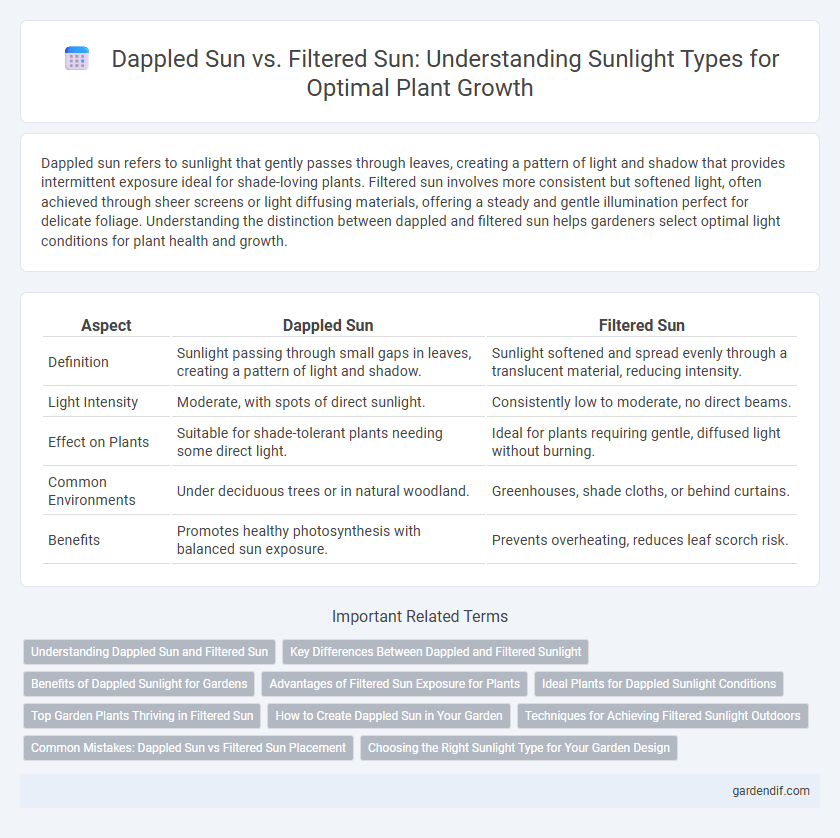
Dappled sun vs filtered sun Illustration
Dappled sun refers to sunlight that gently passes through leaves, creating a pattern of light and shadow that provides intermittent exposure ideal for shade-loving plants. Filtered sun involves more consistent but softened light, often achieved through sheer screens or light diffusing materials, offering a steady and gentle illumination perfect for delicate foliage. Understanding the distinction between dappled and filtered sun helps gardeners select optimal light conditions for plant health and growth.
Table of Comparison
| Aspect | Dappled Sun | Filtered Sun |
|---|---|---|
| Definition | Sunlight passing through small gaps in leaves, creating a pattern of light and shadow. | Sunlight softened and spread evenly through a translucent material, reducing intensity. |
| Light Intensity | Moderate, with spots of direct sunlight. | Consistently low to moderate, no direct beams. |
| Effect on Plants | Suitable for shade-tolerant plants needing some direct light. | Ideal for plants requiring gentle, diffused light without burning. |
| Common Environments | Under deciduous trees or in natural woodland. | Greenhouses, shade cloths, or behind curtains. |
| Benefits | Promotes healthy photosynthesis with balanced sun exposure. | Prevents overheating, reduces leaf scorch risk. |
Understanding Dappled Sun and Filtered Sun
Dappled sun refers to sunlight that passes through the irregular gaps of tree leaves, creating a pattern of light and shadow that provides partial shade ideal for shade-loving plants. Filtered sun describes sunlight that is diffused through a semi-transparent barrier like a sheer curtain or greenhouse glazing, resulting in softer, less intense light suitable for sensitive foliage. Both light conditions moderate the intensity and heat of direct sunlight, promoting healthy plant growth in environments where full sun exposure could cause stress or damage.
Key Differences Between Dappled and Filtered Sunlight
Dappled sun creates a pattern of light and shadow caused by sunlight passing through leaves, resulting in intermittent exposure with varying intensity, ideal for shade-loving plants. Filtered sun refers to sunlight that consistently passes through a semi-transparent material or tree canopy, producing a more uniform and less intense light beneficial for plants requiring moderate sunlight. Understanding these distinctions helps gardeners optimize plant placement for growth, as dappled sun offers fluctuating light while filtered sun provides steady, gentle illumination.
Benefits of Dappled Sunlight for Gardens
Dappled sunlight provides gardens with a unique balance of light and shade, promoting healthy plant growth by preventing leaf scorch and reducing water evaporation from the soil. This gentle, scattered light is especially beneficial for shade-tolerant plants such as ferns, hostas, and begonias, helping them thrive without the stress of intense direct sun. Unlike filtered sun, which may be more uniform, dappled sunlight mimics natural forest conditions, enhancing biodiversity and supporting a microclimate ideal for a variety of garden species.
Advantages of Filtered Sun Exposure for Plants
Filtered sun exposure provides plants with a balanced amount of light, reducing the risk of leaf scorch and dehydration common in direct sunlight. This type of light enhances photosynthesis efficiency by delivering consistent, diffused rays that penetrate deeper into the foliage. Many shade-tolerant and understory plants thrive under filtered sun, promoting healthier growth and vibrant foliage compared to dappled sun conditions.
Ideal Plants for Dappled Sunlight Conditions
Dappled sunlight provides intermittent light through tree canopies, creating a unique environment ideal for shade-tolerant plants like hostas, ferns, and impatiens that thrive without direct harsh sun exposure. These plants have adapted to flourish under variable light conditions, maximizing photosynthesis during brief sunflecks while avoiding leaf scorch. Choosing species suited to dappled sunlight ensures optimal growth and vibrant foliage in partially shaded gardens.
Top Garden Plants Thriving in Filtered Sun
Top garden plants thriving in filtered sun include ferns, hostas, and astilbes, which flourish under partially shaded conditions where sunlight is softened by tree canopies or structures. These plants benefit from the reduced intensity of filtered sun, preventing leaf scorch and promoting lush, vibrant growth. Filtered sunlight mimics natural forest understory light, making it ideal for shade-loving perennials and foliage plants that require consistent but gentle light exposure.
How to Create Dappled Sun in Your Garden
Creating dappled sun in your garden involves strategically placing trees or large shrubs with gaps in their foliage to allow intermittent sunlight to reach the ground, mimicking natural light patterns. Use plants with varied leaf sizes and layering to enhance the scattering of light and provide optimal shade for shade-tolerant plants. Positioning garden structures such as pergolas with climbing vines also adds to the effect by partially breaking sunlight into spots.
Techniques for Achieving Filtered Sunlight Outdoors
Creating filtered sunlight outdoors involves using natural elements such as trees, pergolas with climbing plants, or shade cloths to diffuse direct sunlight, reducing intensity while preserving brightness. Strategic placement of lattice panels or translucent materials allows controlled light penetration, mimicking dappled patterns and protecting plants or outdoor spaces from harsh rays. Employing these techniques supports optimal light conditions for sensitive vegetation and enhances outdoor comfort by balancing shade and illumination.
Common Mistakes: Dappled Sun vs Filtered Sun Placement
Dappled sun occurs when sunlight passes through the moving or stationary foliage, creating a pattern of light and shadow, while filtered sun refers to consistent, diffused light passing through a screen or sheer material. A common mistake is placing plants that require filtered sun in dappled sunlight areas, leading to stress or sunburn due to fluctuating light intensity. Proper identification and placement according to specific plant needs ensure optimal growth and prevent damage from incorrect sun exposure.
Choosing the Right Sunlight Type for Your Garden Design
Dappled sun provides intermittent sunlight through the leaves of trees, ideal for shade-loving plants like ferns and hostas. Filtered sun offers consistent, softer light through a translucent medium or light canopy, supporting a wider variety of plants, including many annuals and perennials. Selecting the right sunlight type depends on your garden's plant preferences and microclimate, ensuring optimal growth and vitality.
Dappled sun vs filtered sun Infographic

 gardendif.com
gardendif.com